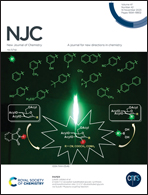3D-QSAR, molecular docking and molecular dynamics analysis of pyrazole derivatives as MALT1 inhibitors†
Abstract
Mucosa-associated lymphoid tissue lymphoma translocation protein 1 (MALT1), which plays an important role in the nuclear factor-kappa B (NF-κB) activation signalling pathway, is a potent target for immunomodulation and anti-tumour drugs. In this paper, 46 MALT1 inhibitors were used to establish 3D-QSAR models to study their conformational relationships, and novel inhibitors with high activity were developed, and the interactions between MALT1 and the inhibitors were further explored using molecular docking and molecular dynamics simulation methods. The comparative molecular field analysis (CoMFA) model had q2 = 0.588, r2 = 0.982, SEE = 0.108; the comparative molecular similarity index analysis (CoMSIA) model had q2 = 0.586, r2 = 0.974, SEE = 0.129. It showed that our established 3D-QSAR model had good statistical significance. On this basis, molecular docking and molecular dynamics simulations were performed to verify the activity of the developed highly active compounds, and they were evaluated with reasonable ADME/T. The results of molecular dynamics simulations showed that the new compounds have better binding affinity. These findings provide necessary theoretical guidance for anti-lymphoma and autoimmune disease drugs.



 Please wait while we load your content...
Please wait while we load your content...